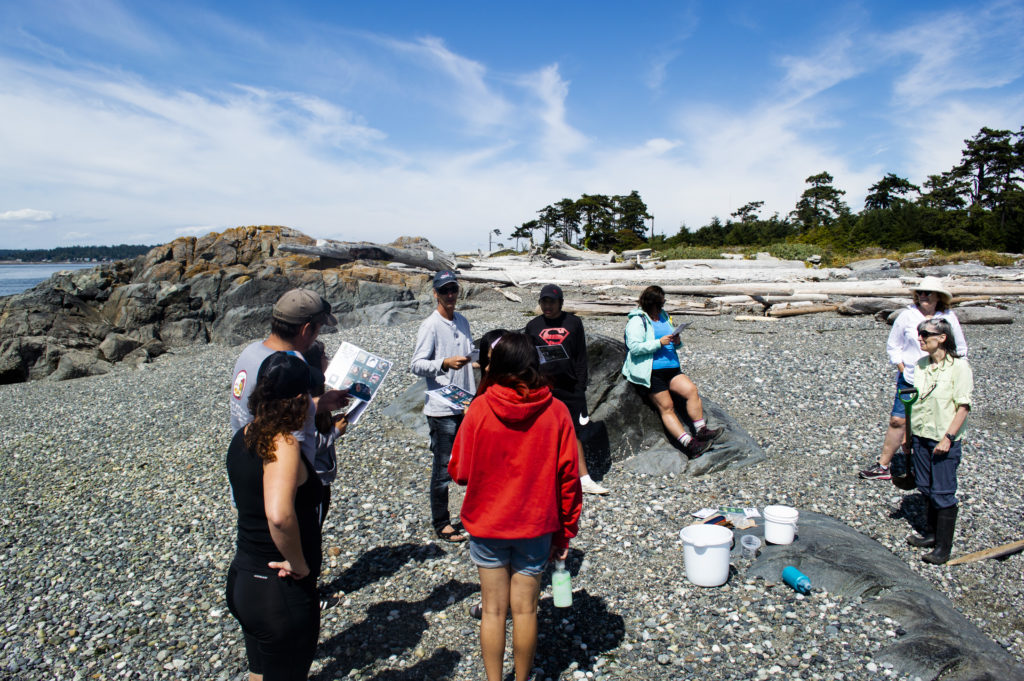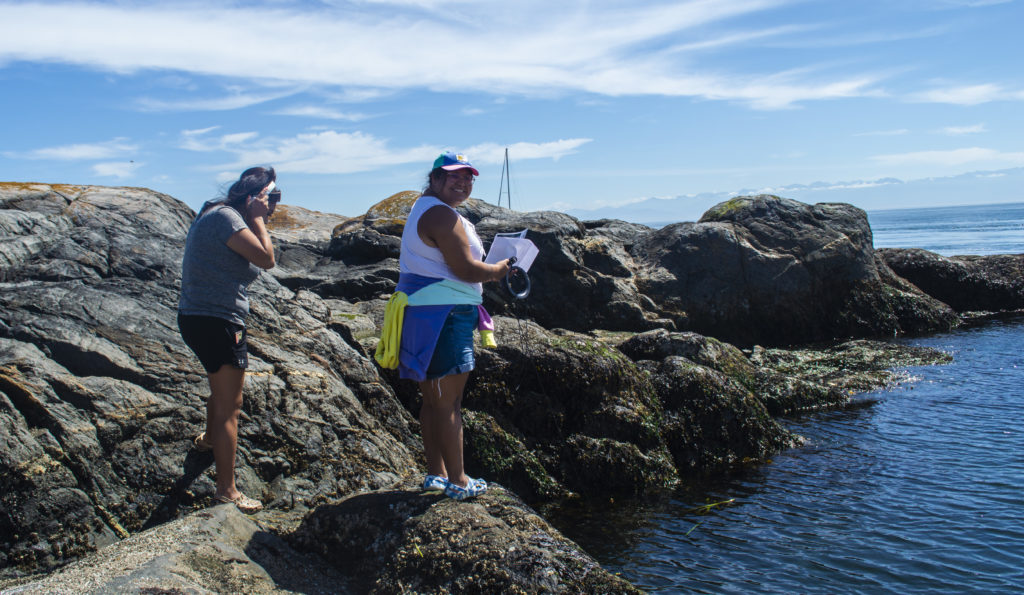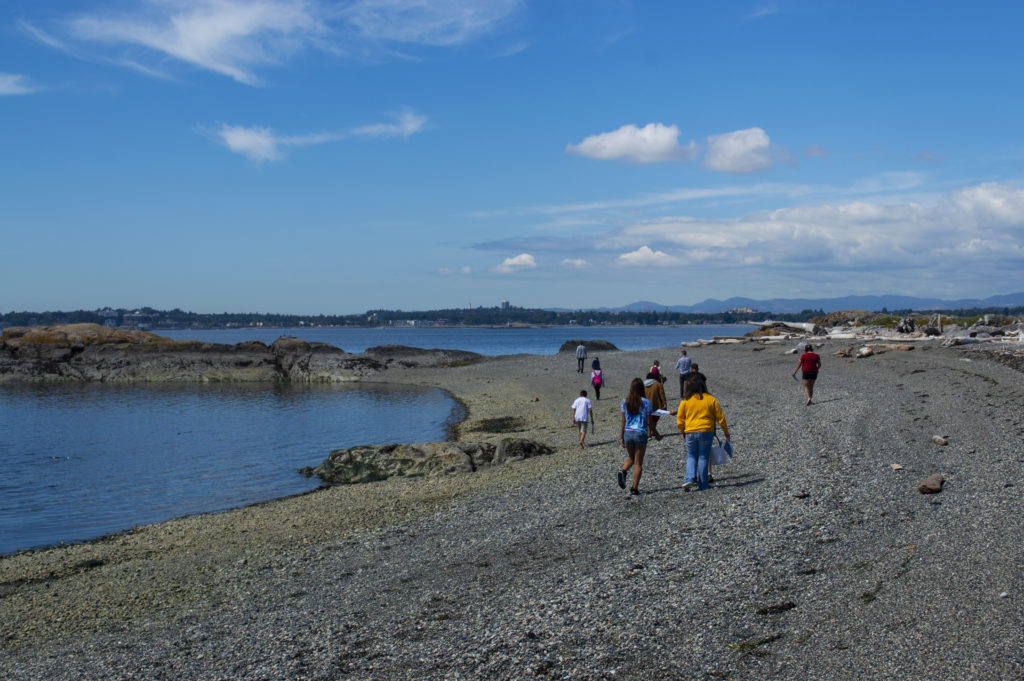Author: Amalis Riera – Acoustic Data Analyst
On Monday August 9, 2021, MERIDIAN team member Amalis Riera was invited to participate in Indigenous land-based learning and community engagement on the Tl’ches Islands as part of the Living Lab Project.
Tl’ches (Lekwungen name), also known as Chatham and Discovery Islands, are Songhees reserve lands located 2 kilometres from Oak Bay on Southern Vancouver Island, BC.
Tl’ches is one of the last locations in Songhees homelands that remains almost as it was 200 years ago, presenting a unique ecosystem that reflects the Songhees relationship to the land and water. It was inhabitated for thousands of years by Songhees-Coast Salish people until colonization in the late 1800’s.

As part of this summer’s Living Lab Indigenous Youth Eco-Stewardship Program, 15 Lekwungen youth aged 16-30 arrived to Tl’ches to gather with knowledge keepers, community members and UVic folks. This included scientists who shared their knowledge and created interactive activities for the youth to learn about tides and currents (Luci Marshall, ONC), clams (John Taylor, UVic), intertidal invertebrates (Louise Page, UVic), and underwater sound (Amalis Riera, MERIDIAN).
Amalis brought a portable hydrophone-and-recorder system to eavesdrop on the island’s underwater shore, as the tide was rising. Young curious souls gasped in wonder as they heard the rustle of a hermit crab scurrying near the hydrophone in a tidepool that was full of tiny sculpins (who were unfortunately too shy to say hello to the audience). The tidepool sounds were more quiet and less variable than those heard under the waves, in a rocky bottom. The rush of the tide could be heard, sounding “like a washing machine” as some would say. A distant speedboat made a convenient appearance, to demonstrate how far their sound can travel, how quickly the volume increases, to decrease as soon as the boat moved away.
The constant popping and crackling sound that is so characteristic of these waters was likened to “fireworks”, which was a refreshing new take on the “frying pan” metaphor.
The Hydrophone Lowering Down and Pulling Back Out events were particularly popular moments for listeners, as they were notoriously loud compared to the sound captured by a static hydrophone.
But the unanimously favourite acoustic experiment was to listen underwater for the sound of a rock thrown by a helpful assistant.
A fun competition ensued to see who could throw one the furthest, thus illustrating how the sound can still be heard for a more distant impact, albeit quieter.
Unbeknownst to all ears present, some local fishes did advertise their presence by making sounds. They just happened to be rare and quiet, making even a trained acoustician second-guess what they heard. Reviewing the amplified recordings after the fact revealed a few clear fish sounds.
Some of the most enthusiastic participants asked questions such as: what is the hearing sensitivity of an orca? How does it compare to human hearing ability? And what determines whether a hydrophone can detect a sound? In case you are curious about the answers, orcas can hear sounds between 1 and 100 kHz, although they are most sensitive to sounds between 16 to 45 kHz (Szymanski et al., 1999), while the human hearing range is approximately between 32 Hz to 16 kHz, but our best hearing is between 250 Hz and 8 kHz (Heffner & Heffner, 2007). As for how far hydrophones can pick up sounds, it depends on the instrument sensitivity, how loud the sound in particular is, whether the animal is vocalizing while facing the hydrophone or another direction, whether there are other sources of noise potentially masking the sound of interest (such as a boat passing by, or wind, rain and currents), whether there is a physical obstacle between the animal and the hydrophone (for example, an island), or whether there is an uneven seafloor (as sound waves can bounce off elements like rocks and be redirected).

The Tl’ches Gathering began and ended with a circle led by Songhees Elder Joan Morris, who shared wise words and memories from her own upbringing and youth on the land. (Joan is the last remaining elder from Songhees who was born on the Island). It was an honour to hear her stories at the end of the day while waiting for her marine ride to return from dropping off the Youth in Oak Bay. The conversation with Joan included painful truths about Canadian history and Indian Hospitals, which she experienced closely. She recommended a book she was carrying in her bag, called “Medicine Unbundled: A Journey through the Minefields of Indigenous Health Care” by Gary Geddes. The book included pictures of Young Joan with her mother on Tl’ches, before they were both taken away.
It was a very enriching day all around, with scientific and cultural exchanges happening in the midst of meaningful connections in a very special place.

Citations:
Michael D. Szymanski, David E. Bain, Kent Kiehl, Scott Pennington, Scott Wong, and Kenneth R. Henry (1999). Killer whale (Orcinus orca) hearing: Auditory brainstem response and behavioral audiograms, The Journal of the Acoustical Society of America, 106: 1134-1141.
Henry Heffner and Rickye Heffner (2007). Hearing ranges of laboratory animals, Journal of the American Association for Laboratory Animal Science, 46: 11-13.